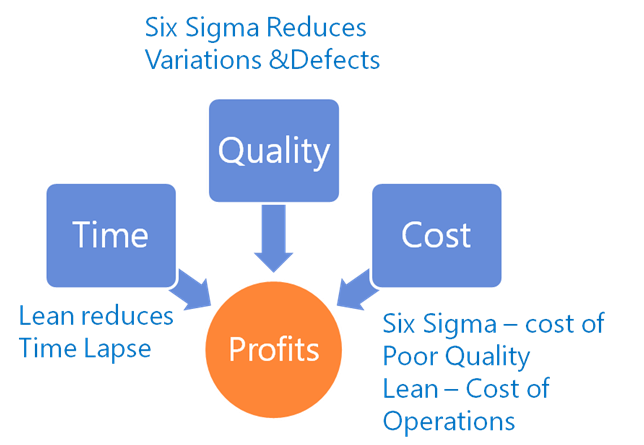
Lean Six Sigma Green Belt Training and Certification
What is Lean Six Sigma?
One of the most Powerful business transformation tools used all over the world across every industrial sector for past tow decades. It is becoming a must-be in many companies in developed countries and in MNCs in India, gaining momentum among many Indian corporate houses in the past decade. Automobile, Electronics, and Banking have already ventured into LSS – improving the quality of our lives and Telecom, medicine, engineering, BPO and more are joining the band creating huge demand of qualified people.
Why is Lean Six Sigma so effective?
Irrespective of industry, Lean Six Sigma is being adapted, followed and appreciated in every
business, as it increases customer satisfaction and improves profit by reducing defects, reducing wastes and so on. While Six Sigma provides a pointed improvement approach and a clear project management framework (DMAIC), Lean brings in the velocity reducing waiting time and related Muda. Six Sigma helps to improve critical processes and Lean works on entire value stream.
Applicable to IT & Services?
We all know Lean and Six Sigma are having their origin in Manufacturing – where millions of products are produced in a given long chain of sequenced activities. Hence, we normally have a mind block with the applicability of this powerful tool in IT and Services. As long as there are customers and their requirements, as long as there is a process and its outcome, Lean Six Sigma is very much applicable.
How can Lean Six Sigma Green Belt help?
The green belt is an intermediate level of training within the Six Sigma hierarchy. Trained Green Belts become empowered and capable of initiating and supporting DMAIC projects on Lean and Six Sigma leading to significant productivity improvement, quality improvement and cost reduction. After completing Green Belt, people can able to collect data, analyse data and implement solutions. Green Belt certification course gives them a hands-on experience with DMAIC approach, Lean Six Sigma Tools and most importantly the perspective of business and customer satisfaction.
Training Content
Introduction to Lean Six Sigma
- What is Lean Six Sigma?
- Whay is Lean Six Sigma Green Belt?
- Evolution of Lean, Six Sigma, and other Quality Management Methodologies
- Why is Lean Six Sigma so effective?
Structure of Lean Six Sigma
- Lean Six Sigma Yellow Belt
- Lean Six Sigma Green Belt
- LSS Black Belt
- LSS Master Black Belt
- Champion
- Basic of Quality
What is Quality?
- Cost of Poor Quality (CoPQ)
- Cost, Price, Profit and Loss
- What is Business Excellence
Basics of Lean
- Cash to Cash Cycle
- 7 Wastes of Lean
- 3 Mu’s of Kaizen
DMAIC – Over View
Define
- What is your problem?
- Project Selection – Understanding Business Needs
- Tools: Kano’s Priority Model
- External and Internal points of identifying projects Understanding of problem
- Voice of Customer – Critical to Quality
- Collection and Analysis of VoC
- Tool: Affinity Analysis
- Yield and Loss Analysis
- Identifying Product Family
- Tool: Product Family Matrix
- Process Maps & SIPOC
- Tools: Process Flow Diagram, SIPOC, Spaghetti, and Value Stream Mapping
- Project Charter
Measure
- Basic Statistics
- Descriptive Statistics
- Inferential Statistics
- Understanding Data
- Central Tendency
- Dispersion
- Probability Distribution
- Types of Data
- How to measure your problem?
- What data do you need to collect?
- Operational Definitions
- Population & Sampling
- Measurement System Analysis
- Data Collection
- Data Screening
- Trend Analysis
- Variation & Consequences
- Do data represent stable process?
- Tool: Control Chart
- Is the data normal?
- Tool: Normality test
- Data Analysis
- Tools: Histogram, Pareto, and Box Plot
- What is your process capability?
- DPMO method
- Cpk method
- Standard Normal distribution
- Calculation of Process Cycle Efficiency
Analyse
- Why your process capability is poor?
- Brainstorming for Possible Causes
- Tool: Fishbone Analysis
- Root Cause Analysis
- Tool: Why-Why Analysis
- Prioritising potential root causes
- Validation of root causes
- Tools: Regression & Correlation, Hypothesis Testing, t – Tests, ANOVA
- Introduction to Design of Experiments
- Bottleneck Identification
- Value & Non-value analysis
- Analysis of 7 Wastes
Improve
- Generate Solutions
- Tool: SCRAP
- Proof of solutions
- Various Lean Six Sigma Solutions
- Flow Layout
- Workstation design
- Kaizen
- 5S
- Setup time reduction
- Overview of TPM
- Mistake Proofing
- Introduction to TRIZ
- Action Plan
- Verification & Scale-up
Control
- How to sustain gains?
- Control plan
- Control charts
- Documentation
- Continuous Improvement
Course Duration
4 days – 32 Hours
Who could attend
- Manufacturing / Operations Managers
- Executives and Shopfloor Supervisors from Manufacturing
- Project Managers, Team Leaders and Key members from IT or Services involved
- Managers and Executives from support services like HR, Accounts, Finance, Procurement, Warehousing, etc.
- Key people from any business who are involved in quality improvement or productivity improvement

